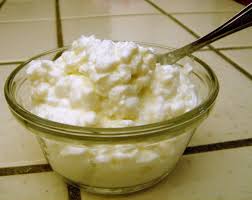by Val Harrison
Making Cottage or Curd Cheese without rennet etc.
A lot of people are put off the idea of making cheese at home by having to buy special equipment and supplies but cottage or curd cheese is really easy to make and requires no special tools that you won’t find in the ordinary kitchen, nor does it require rennet or any special ingredients
Cheese has always been a way of storing a surplus of milk for use when the cow or sheep were dry and making your own cheese at home is a great way to store any surplus milk you may find yourself with.
In terms of cost, home made cheese will not save you money but if you find you have a couple of pints about to turn in the fridge or the supermarket has over stocked and reduced some milk, you can store this by making cottage cheese. Although cottage, or curd cheese as some people call it, doesn’t store for a long time in the fridge it will freeze easily.
We’ve never found out how long our cottage cheese will keep for because it tends to be eaten quickly. This method produces a different cheese than cottage cheese made conventionally with rennet. It’s firmer and more granular, which we like and you can add different flavourings but we just like salt and black pepper,
All cheeses are made from the coagulated lumps from milk – the curds – with the liquid part called the whey, hence curds and whey. Although a lactic starter can be used when making cottage cheese, it is not absolutely necessary, the same chemical reaction of turning the milk, or curdling, can be obtained from the use of vinegar or lemon juice which most people have in their kitchen.
So why not spend half an hour making your own cottage cheese? It tastes better than shop bought and the process is absolutely fascinating.
 Recipe for Cottage Cheese
Recipe for Cottage Cheese
Ingredients:
- 2 pints (1200 ml) semi-skimmed or skimmed milk
- 2 tablespoons (30 ml) lemon juice or white vinegar
- Pinch of salt
Equipment:
- Saucepan – stainless steel or enamelled
- Wooden Spoon
- Fine Sieve
Method:
- Pour the milk into the saucepan.
- Heat on hob until it is very hot, but do no boil, stirring occasionally with a wooden spoon.
- Allow to cool for a couple of minutes.
- Add 2 tablespoons (30 ml) of lemon juice or vinegar.
- Stir and watch the hot milk separate into the curds and whey.
- Allow to cool further.
- Pour the curds and whey through a sieve to catch the curds.
- Discard the whey or use it instead of water in bread making, or for any recipe calling for sour milk or buttermilk.
- Transfer the curds into a small bowl and add a pinch of salt.
You’ve got cottage cheese!
Optional Extras to your Cottage Cheese:
- Add a tablespoon of double-cream to the curds for a richer consistency.
- Add chopped chives, chopped spring onions, herbs.
- Sprinkle with a little black pepper.
- Whatever takes your fancy!
Problems with Cottage Cheese:
If the milk is not curdling it may be the milk. Only use regular pasteurised milk not UHT.
Add a little more acid in the form of lemon juice or vinegar to correct.


Leave a Reply